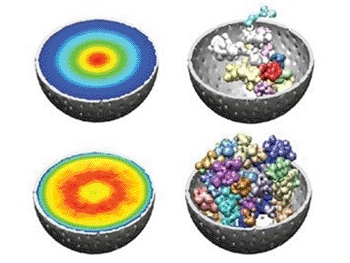First 3D Map of Human Genome Created
By LabMedica International staff writers
Posted on 18 Jan 2012
For the first time, scientists have developed a way to create precise three-dimensional (3D) models of the entire DNA strand of a cell.Posted on 18 Jan 2012
The genome plays a fundamental role in the mechanisms of nearly all human cells, and defects in its structure are believed to cause various disorders, including cancer. Understanding the structure of the genome is crucial to understanding its function as a whole, according to Lin Chen, a professor of molecular biology at the University of Southern California (USC; Los Angeles, USA) Dornsife College of Letters, Arts, and Sciences. “Everything biological works in the three dimensions,” Prof. Chen said. “Therefore, to understand it completely, you have to understand it three-dimensionally.”

Image: Researchers analyzed the differences and similarities in genome structure between various cells to create a model of the human genome (Photo courtesy of the University of Southern California).
The technique adds a key clue of the mystery for scientists trying to understand the genome--the foundation of life--in normal and diseased cells. One of the most likely applications of this research will be to identify potentially cancerous cells based on structural defects in the cell’s genome, according to Prof. Chen. “Hopefully in the future, these studies allow scientists to better understand how the genome is involved in disease and how its function can be regulated in those circumstances,” Prof. Chen said.
The DNA, crunched up inside the nucleus, forms hundreds of millions of contacts with itself. Using a new technique, USC researchers plotted out the location of each of those DNA-on-DNA contacts and used advanced computer algorithms to model the results in 3D. “It provides you with a completely new prospective in the genome,” Prof. Chen said. The study was published online in the journal Nature Biotechnology on December 25, 2011, ahead of its publication in the print edition.
By studying the differences and similarities in genome structure between various cells, scientists are able to distinguish what are the basic principles of 3D organization. Moreover, the structure allows scientists to see where each gene is located relative to any other gene and how this arrangement is important to cellular functions.
The technology used by the USC researchers takes into account the fact that each cell is somewhat different--the DNA does not always scrunch in the precise same way. “There is not a single structure of a genome,” said Frank Alber, assistant professor of computational biology at USC Dornsife.
By doing a statistical analysis of many genomes, the scientists were able to determine “preferred positions” for the DNA strand, providing an idea of how it most likely is to appear.
Related Links:
University of Southern California













